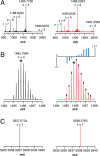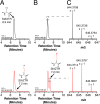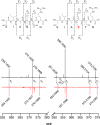A Radical Clock Probe Uncouples H Atom Abstraction from Thioether Cross-Link Formation by the Radical S-Adenosyl-l-methionine Enzyme SkfB
- PMID: 29965747
- PMCID: PMC6094349
- DOI: 10.1021/acs.biochem.8b00537
A Radical Clock Probe Uncouples H Atom Abstraction from Thioether Cross-Link Formation by the Radical S-Adenosyl-l-methionine Enzyme SkfB
Abstract
Sporulation killing factor (SKF) is a ribosomally synthesized and post-translationally modified peptide (RiPP) produced by Bacillus. SKF contains a thioether cross-link between the α-carbon at position 40 and the thiol of Cys32, introduced by a member of the radical S-adenosyl-l-methionine (SAM) superfamily, SkfB. Radical SAM enzymes employ a 4Fe-4S cluster to bind and reductively cleave SAM to generate a 5'-deoxyadenosyl radical. SkfB utilizes this radical intermediate to abstract the α-H atom at Met40 to initiate cross-linking. In addition to the cluster that binds SAM, SkfB also has an auxiliary cluster, the function of which is not known. We demonstrate that a substrate analogue with a cyclopropylglycine (CPG) moiety replacing the wild-type Met40 side chain forgoes thioether cross-linking for an alternative radical ring opening of the CPG side chain. The ring opening reaction also takes place with a catalytically inactive SkfB variant in which the auxiliary Fe-S cluster is absent. Therefore, the CPG-containing peptide uncouples H atom abstraction from thioether bond formation, limiting the role of the auxiliary cluster to promoting thioether cross-link formation. CPG proves to be a valuable tool for uncoupling H atom abstraction from peptide modification in RiPP maturases and demonstrates potential to leverage RS enzyme reactivity to create noncanonical amino acids.
Conflict of interest statement
The authors declare no competing financial interest.
Figures




Similar articles
-
SkfB Abstracts a Hydrogen Atom from Cα on SkfA To Initiate Thioether Cross-Link Formation.Biochemistry. 2016 Aug 2;55(30):4131-4. doi: 10.1021/acs.biochem.6b00598. Epub 2016 Jul 21. Biochemistry. 2016. PMID: 27410522 Free PMC article.
-
Structural and spectroscopic analyses of the sporulation killing factor biosynthetic enzyme SkfB, a bacterial AdoMet radical sactisynthase.J Biol Chem. 2018 Nov 9;293(45):17349-17361. doi: 10.1074/jbc.RA118.005369. Epub 2018 Sep 14. J Biol Chem. 2018. PMID: 30217813 Free PMC article.
-
Two [4Fe-4S] clusters containing radical SAM enzyme SkfB catalyze thioether bond formation during the maturation of the sporulation killing factor.J Am Chem Soc. 2013 Jan 23;135(3):959-62. doi: 10.1021/ja310542g. Epub 2013 Jan 9. J Am Chem Soc. 2013. PMID: 23282011
-
Radical SAM enzymes in methylation and methylthiolation.Metallomics. 2012 Nov;4(11):1149-54. doi: 10.1039/c2mt20136d. Epub 2012 Sep 19. Metallomics. 2012. PMID: 22992596 Free PMC article. Review.
-
Auxiliary iron-sulfur cofactors in radical SAM enzymes.Biochim Biophys Acta. 2015 Jun;1853(6):1316-34. doi: 10.1016/j.bbamcr.2015.01.002. Epub 2015 Jan 15. Biochim Biophys Acta. 2015. PMID: 25597998 Review.
Cited by
-
RaS-RiPPs in Streptococci and the Human Microbiome.ACS Bio Med Chem Au. 2022 Aug 17;2(4):328-339. doi: 10.1021/acsbiomedchemau.2c00004. Epub 2022 Mar 21. ACS Bio Med Chem Au. 2022. PMID: 35996476 Free PMC article. Review.
-
Current Advancements in Sactipeptide Natural Products.Front Chem. 2021 May 20;9:595991. doi: 10.3389/fchem.2021.595991. eCollection 2021. Front Chem. 2021. PMID: 34095082 Free PMC article. Review.
-
New developments in RiPP discovery, enzymology and engineering.Nat Prod Rep. 2021 Jan 1;38(1):130-239. doi: 10.1039/d0np00027b. Epub 2020 Sep 16. Nat Prod Rep. 2021. PMID: 32935693 Free PMC article. Review.
-
Ruminococcin C, a promising antibiotic produced by a human gut symbiont.Sci Adv. 2019 Sep 25;5(9):eaaw9969. doi: 10.1126/sciadv.aaw9969. eCollection 2019 Sep. Sci Adv. 2019. PMID: 31579822 Free PMC article.
-
New Role for Radical SAM Enzymes in the Biosynthesis of Thio(seleno)oxazole RiPP Natural Products.Biochemistry. 2021 Nov 16;60(45):3347-3361. doi: 10.1021/acs.biochem.1c00469. Epub 2021 Nov 3. Biochemistry. 2021. PMID: 34730336 Free PMC article.
References
-
- Sofia H. J.; Chen G.; Hetzler B. G.; Reyes-Spindola J.F.; Miller N. E. (2001) Radical SAM, a novel protein superfamily linking unresolved steps in familiar biosynthetic pathways with radical mechanisms: functional characterization using new analysis and information visualization methods. Nucleic Acids Res. 29, 1097–1106. 10.1093/nar/29.5.1097. - DOI - PMC - PubMed
Publication types
MeSH terms
Substances
Grants and funding
LinkOut - more resources
Full Text Sources
Other Literature Sources
Molecular Biology Databases
Miscellaneous

